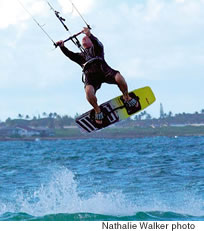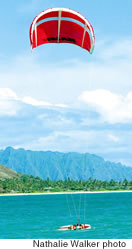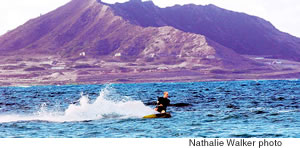Oh, Go Fly A Kite!
Kiteboarding is just five years old, but it’s the hottest sport in Hawaii

By .(JavaScript must be enabled to view this email address)
E-mail this story | Print this page | Archive | RSS
to feel the wind on their skin or look at the trees to tell what the wind speed is.

Lane shows off in the Kailua surf
“There’s a palm tree by my house in Kailua that I look at to check wind direction and speed,” says Groman. “I’ve been looking at it for so long I can just tell. I don’t use any of those numbers to call to check the winds. This tree is a lot better. I trust it more.”
Sue Kamp, 58, has been kite-boarding for three years. A retired teacher, she lives in town but comes out to Kailua Beach every day after checking the NOAA buoys.
But even if the winds aren’t up, Kamp says she takes the opportunity to walk up and down the beach. Of course, she’d rather be enjoying the feeling of freedom she gets from being on the water.

Kaneala Sheldon gets ready
to re-launch from the water
Kailuan Duane Kimmage, a windsurfer for more than 20 years, took up kiteboarding when the sport started five years ago, and is now teaching his wife Barbara to kiteboard as well.
“My wife has been watching me kiteboard for years, and I’ve been trying to get her into it,” says Kimmage, who works as the airport manager for Qantas Airlines. (Barbara is a pilot for Air Canada.) “In the beginning, kite-boarding was a little more dangerous and the safety equipment wasn’t as good, so Barbara was worried about getting hurt, but now they’ve made some great advancements.”
This summer, Barbara told her husband she was ready to try.
“She just loves it,” says Kimmage as he stands on Kailua Beach watching his wife in the water. “Now the only problem is I stand on the beach while she’s out there so I don’t get as much water time, but the ultimate goal is we both get out there and kite together.”
Naish says that technology has brought kiteboarding to a much more comfortable level for a lot of people. A full set of gear, including kite, board and harness, will run you about $1,500 to $2,000.
“The kites are much more controllable now,” says Naish, whose legendary windsurfer/kit-boarding son Robbie has patents for the dozens of kites, boards and gear Naish Hawaii produces. “In the beginning, people would need a quiver of at least three kites, sometimes four or five, to have the right size for all kinds of wind. Now you need only one or two.”
The art of kitesurfing dates back to 13th century China when kites were used as a mode of transportation to add momentum and energy to mobilize canoes and later to glide carts on land.
Lane agrees that in today’s world, safety and technology have changed a lot in the short time kiteboarding has been around.
“Every year they come out with better kites with more safety features, more release mechanisms and kites that are more forgiving,” he says.
Lane’s oldest student was a 77-year-old woman who had macular degeneration of her eyesight.
“She couldn’t drive, but she learned how to kite and now she’s going 350 yards downwind and 35 yards upwind,” he says. “We taught her with a walkie-talkie strapped to her head so we could guide her safely and make sure she put the kite in the right place.”
Safety is a huge concern for the kiteboarding community not only because of the extreme nature of the sport itself, but especially in the case of Kailua Beach, because it’s done while sharing the beach with kayakers, windsurfers, joggers and swimmers.

Lane says he’d give up every other extreme sport just
for the short time he’s been kiteboarding
“The kiteboarding community has worked really hard to maintain safety standards,” says Naish. “There haven’t been any kiters seriously hurt in Kailua. But something to keep in mind is that to do this sport, you really have to have maturity and good judgment. You have to be able to stay focused, whether you’re 15 or 50, because there’s a lot of potential for danger.”
Groman says there are a couple of rules for Kailua Beach that all kiteboarders must follow.
“Respect the people and the beach first,” he says. “And stay as far away from the people as possible. The people on the beach always have the right of way.”
Groman has been kiteboarding since 1999, before there were any instructors to teach him how. He had tried surfing and windsurfing before but thought windsurfing was too difficult, so he taught himself to kiteboard. This is not something he advises today, however.
“I made every mistake in the book,” he says. “I put my kite up into trees. I wish I’d had an instructor because taking those lessons will save your gear, your body and everyone else around you.”
Groman says the thing that gets most kiteboarders into trouble is over-confidence.
“I saw a guy get picked up and thrown up over the trees one time because of that,” he says. “Even though I know what I’m doing pretty well, I’m always super cautious. Anything can happen with this sport, which is also why people like it so much because it’s exciting. But it’s not a game, and the kite is not a toy.”
Though kiteboarding is the fastest growing sport in the world, there is only a small percentage of people who are doing it on a regular basis. This has created a close-knit community of kiteboarders who, at least in Kailua, are on a first-name basis with each other, help police the beach, offer kiteboarding tips to one another and help each other launch and land safely.
“There’s a lot of camaraderie, a lot of encouragement and sharing of ideas,” says Lane. “The good thing about kiteboarding is it can be individual as well, but it’s not like everyone is fighting for the same wave and dropping in on each other and causing tension. Everyone gives the other person the right of way and we all watch each other to make sure we’re being safe and following the rules.”
As Kimmage describes it, kite-boarding is freedom. Almost like a magic carpet ride, you’re flying on the water with nothing in front of you but gorgeous scenery and open space - things that make you remember why you’re lucky to live in Hawaii.
Page 2 of 2 pages for this story < 1 2
E-mail this story | Print this page | Comments (0) | Archive | RSS
Most Recent Comment(s):








